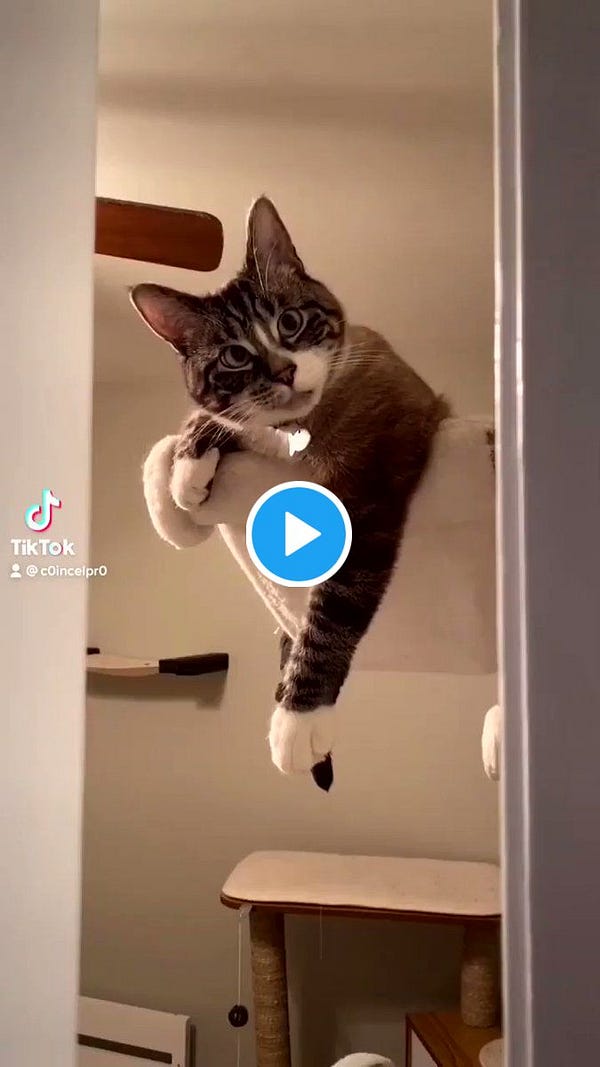Hi,
So here are some things I’ve been thinking about this week:
Unabashed recommendation for the pilot of Superman and Lois
Last week, the CW’s new Superman and Lois series premiered. The show, a spinoff of the vast Arrowverse of superhero shows on the CW, is, well, pretty much perfect.
In addition to being fun, and extremely high quality, the show just gets who Superman and Lois are. It gets that Superman isn’t supposed to be an unfeeling god; contra Tarantino, the show doesn’t see Clark Kent as a disguise and a critique of the human condition — Clark Kent is who Superman really is. He’s genuinely nervous and bumbling around Lois Lane because he thinks she’s the best reporter in the world, and so she symbolizes American Journalism to him — it’s not an act.1 He’s happy and joyful and dutiful and soulful, and feels emotions boldly. He fights against the bad guys because he hates bullies and cruelty and parents gone too soon, not out of wrath or superiority or contempt.
Being Superman isn’t about being better than men, it’s about being the best example of being a man.
(And being Lois Lane isn’t about being an idiot reporter who couldn’t see the Biggest Story in Human History in front of her face — it’s about being the reporter who was so good at her job that she convinced her source to share the Biggest Story that He Was Never Going to Tell. Even though he had, unbeknownst to her, perfect visibility into her reporting pipeline and the option of just cutting her off and reporting out his own adventures.)
And so, we join Superman and Lois a few years down the road, with twin boys entering high school (it is a CW show, after all), facing challenges that America, and American journalism face:
Billionaires buying out newspapers to asset-strip them
Small towns being ravaged by illegal drugs and losing all their brightest talent to big urban cities2
Farms being over-leveraged and financially failing
Kids feeling like they’re stuck in a zero-sum fight against each other to be the one that makes it
A supervillain in a battle suit blowing up nuclear power plants.
(Okay, it’s not all metaphor).
And the question the show seems to ask is: What happens when you can go home, but home isn’t the same any more? If you were raising a child in the same place as your idealized childhood, but the old answers don’t work, what does that mean? What happens, in other words, when we need to start retelling the story of Truth, Justice, and the American Way, for a new generation, from the beginning?
I’m excited to see their answer.
It’s ethical for you to get the vaccine if you’re allowed
(This may be obvious to some, but isn’t to everyone, so here goes)
Having seen a few friends wrestle with this question this week, let me affirm something: if you genuinely fit the current rules, it’s ethical for you to try to get the vaccine. Some folks worry — out of genuine, loving concern — that trying to get the vaccine will crowd out a dose for someone else. Others, like Stanford (still reeling from their “whoops we didn’t care about vaccinating our resident MDs” scandal), have sent messages to their community urging folks to second-guess public health officials and not get vaccinated even though they’re allowed:



This is dumb (and Stanford kinda reversed itself, but only in a weasel-worded way). Public health officials understand that, as you expand into more tiers, you’re by definition saying that sometimes a lower-tier person will get vaccinated before a higher-tier person. But public health officials know that too, and accepted a loss of strict order-of-priority to get more shots into arms.
Let me talk about the example I know best, California. In California, there’s plenty of folks who want the vaccine, and it’s not always easy to find a place to get a dose if you’re eligible. Actual real-world demand (e.g., the amount of folks who are driven by desire to get vaccine and have the ability to find and sign up via the Byzantine maze of options available) is imperfectly aligned with our proxies that determine supply (e.g., population segments, counties), so at any given set of rules about who can get the vaccine, there’s going to be some places where demand no longer takes up all of the supply.
As time goes on, public health officials see more and more of those gaps between demand and supply. Basically every day in California, there are one or more super-sites, with hundreds or thousands of slots open that day, that has to shout to get folks to come to it3, as well as thousands more slots open that day across the pharmacies and hospitals. After enough of the “let’s scramble to get the doses used” events, public health officials open up eligibility to the next tier as well, to ensure that doses don’t sit on shelves for longer or even expire unused. After all, even if a grocery worker or a 30-something person with asthma or a heart condition isn’t (necessarily) as vulnerable as a 65-year-old, having that recipient vaccinated:
Prevents a dose from being wasted today — injecting that dose now means that a dose in the future got freed up; and the cold logic of second dosing means that the sooner the first dose is used, the sooner it frees up a dose in the future
May, in some circumstances, actually be vaccinating someone at true higher risk — there are plenty of 65-year-olds that have enough resources to bunker up safely while ostensibly “lower-risk” folks have jobs or medical conditions that put them at higher risk
Reduces the recipient’s odds of needing an ICU bed that someone else might need
Greatly reduces the infectivity of that person and their chance of infecting others (remember, the COVID vaccine all but eliminates your risk of hospitalization, and likely greatly reduces your chance of a low-symptom or asymptomatic case, but probably doesn’t eliminate it entirely)
Public health officials are OK with the tiers being an “allow-list,” not a strict hierarchy, and have accepted this tradeoff in order to get more shots into arms faster and protect more people.
You should trust their judgment, and try in good faith to get a vaccine if you’re allowed.
DC-specific vaccine-hunting advice
As you almost certainly know by now, DC vaccine’s process is not the same process as California. There are essentially 4 channels (contrary to belief that there is only 1):
Medical channels (e.g., you work in a hospital, or, increasingly, are an active patient at that hospital)
Continuity-of-government channels (e.g., you’re Nancy Pelosi4)
The totally under-reported channel of vaccines being distributed by groups like Bread in the City. These groups have pre-existing relationships with folks who are extremely low-income, are elderly, or otherwise wouldn’t be well-reached by the channels that would reach recipients of this newsletter. Their work is essential and they are continuing to iterate on their model to be even better.
The general channels of vaccinate.dc.gov and the DC vaccine phone line.
Most folks who receive this newsletter, work in DC, and have medical conditions that make them eligible for vaccine under DC’s current Phase 1C would use option 4. Having helped a few people get through the process now, here are some tips:
The website and phone lines actually open about 2 minutes before they say they do. Be ready then, and try both at once.
The original draft of this newsletter intended to have website-specific advice, but as DC has finally decided to fix their website,5 it’s probably not worth sharing that advice as it will likely all change. So, uh, display adaptability, I guess. Regardless, it’s probably wise to have your autofill on Chrome ready so you can quickly fill in all of your address information without typing. You may want to use an incognito window if it errors out, that seems to fix it for unclear reasons (presumably they’re setting some sort of cookie).
The phone line quickly (within 1 min) gets overwhelmed by too many calls and error out or play a voicemail saying that they’re dealing with “unusually high call volume.” But after a while, the call volume will decline and you may be able to get through again. Here is the phone tree path you want: As soon as you get the line to properly pick up, press 1 for English. WAIT through the "if this is an emergency call 911" message and then as soon as it begins listing reasons for calling, you can press 4 for COVID-related calls. It will then start asking you if you're calling about vaccine or about testing, press 1 for vaccine. Then it will ask if you're eligible and start explaining the criteria, press 1 for yes, and then it will put you on hold. STAY on hold until you get a human, who will either tell you they’re out of vaccines, or take your info to schedule you an appointment.
While calling the phone line, also continue checking the web site and refreshing it.
And may we all, soon, be in an era where there is enough vaccine for all.
(I will cover non-DC-specific strategy in a future newsletter.)
Five households stand between zip code 20422 and total immunity



May this iconic duo bless your timeline
May this BIRD bring you DRAMA
May this internet meme cat enjoy your cheese plate
May this ghost haunt your LEGO set
Disclosures:
Views are my own and do not represent those of current or former clients, employers, friends, or my cat.
I may on occasion use Amazon Affiliate or similar links when referencing things I’d tell you about anyways. As an Amazon Associate I earn from qualifying purchases; I donate the proceeds to charity. While Substack has a paid subscription option, I don’t have any plans to use it at this time and anyone who gets this newsletter now surely won’t be ever paying for their subscription.
Though the late, great Christopher Reeve did the very best portrayal of a Superman that does see Clark Kent as a disguise — if you’ve never watched how he uses posture and voice to shift characters, you owe it to yourself to start at ~1:40:
“Smallville vs. Metropolis” isn’t exactly what you’d call a subtle point, and Siegel and Shuster were probably more familiar with rural life you’d expect if your understanding of what it was like then to be a Jewish teenager in Cleveland is based on an idea of what it’s like now. At the time, cities were still becoming the epicenter of American life, and 25% of Americans were still farmers. Heck, just a few blocks up the road from where Siegel and Shuster lived on 105th and Kinsman was Cleveland’s then-White-Christians-only suburb Shaker Heights — later one of the most famous case studies of suburban development and racial integration in 20th-century America — and in 1930 Shaker Heights was still considered the countryside…
Literally, I learned of a new supersite with hundreds of open slots today while finalizing this newsletter. It happens all the time in California now.
Arguably, CA’s turnaround story from lagging to leading is the biggest story that we don’t understand. I mean, I literally work on it every day and I don’t understand it. Anyone who says they fully do is either wrong or lying.
If so, thank you for your newsletter patronage.
For people who know what this means: they didn’t have Cloudflare set up on it until Sunday. Yeah.















